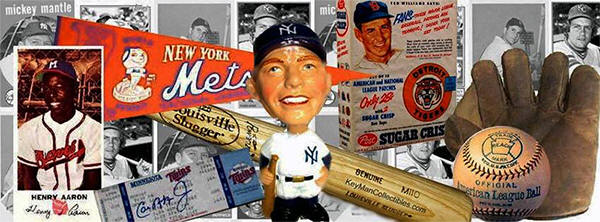|
|
|
|
| KeyMan
Collectibles |
NEWSLETTER |
November 2022 |
|
|
Baseball Themed Postcards and Dating |
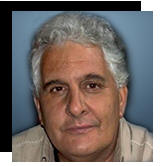 |
|
Steven KeyMan |
|
|
-
By Steven KeyMan |
|
Founder of
Keymancollectibles.com,
and a long time
collector, Steven
KeyMan has more than 30
years of experience in
researching, and
cataloging information
on Baseball
Memorabilia.
Researching his own personal
collection, and helping others find
information on their
collectibles, the
website grew into the
largest online resource
for baseball
memorabilia |
|
|
|
|
|
| |
Ask
Steven: Direct your questions or feedback,
about Baseball Memorabilia to Steven KeyMan
Steve@keymancollectibles.com You can also Send
KeyMan pictures of your personal Memorabilia Display,
and get your own Free
Collectors Showcase Room featured on the website.. |
|
|
|
|
| |
Collecting postcards, is the third largest hobby
after collecting stamps and money.
Baseball Postcards takes the hobby to
the next level, but still affordable to
the average collector. Sold in gift
shops, or souvenir stands at ballparks,
famous restaurants, museums, or travel
destinations, many found there way into
our family photo albums.
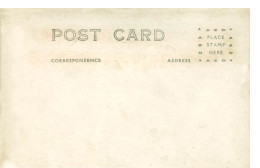 In 1903, Kodak introduced a
camera designed for postcard-size film,
allowing the public to take photographs
and have them printed on postcard
backs. In 1907, Kodak introduced a
service called “Real Photo Postcards”
(RPPCs), which enabled customers to
make a postcard from any picture they
took. In 1902, Eastman Kodak
began selling photo paper with a
pre-printed postcard back. In 1903, Kodak introduced a
camera designed for postcard-size film,
allowing the public to take photographs
and have them printed on postcard
backs. In 1907, Kodak introduced a
service called “Real Photo Postcards”
(RPPCs), which enabled customers to
make a postcard from any picture they
took. In 1902, Eastman Kodak
began selling photo paper with a
pre-printed postcard back.
The photo
paper was made available under Kodak
subsidiary companies such as: Velox,
ASO, AZO, EKC (1940-1950), Solio
(1903-1920s), Artura (1910-1924), and
Aristo. Velox, and AZO postcards can be dated by noting the different shapes on the corners
of the stamp box. Velox - squares in
corners 1901-1914, diamonds in corners
1907-1914, and 4 triangles pointing up
1909-1914. The AZO stamp box is charted below.
|
|
| |
|
|
| |

|
|
| |
4 Triangles pointed up
1904-1918 |
Diamonds
1907-1909 |
Triangles 2 up 2 down
1918-1930 |
Empty Corners
1922-1926 |
Squares
1926-1943 |
|
|
| |
|
|
| |
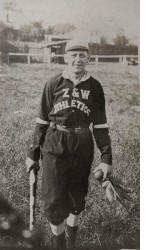 Real
photo postcards documented life in
America from 1907-1943 as seen through
the lens of both ordinary people, and
the professional photographer. The
postcards captured a wide variety of
subjects that were used for a variety
of purposes. Given to relatives or
friends, and landing in family photo
albums. Uncle John in his baseball suit
or a local team. Real
photo postcards documented life in
America from 1907-1943 as seen through
the lens of both ordinary people, and
the professional photographer. The
postcards captured a wide variety of
subjects that were used for a variety
of purposes. Given to relatives or
friends, and landing in family photo
albums. Uncle John in his baseball suit
or a local team.
Some real photo postcards were produced
professionally used for advertising or
sold to the public at stores. Postcards
picturing baseball players included the
stars of the day such as; Ty Cobb, Babe
Ruth, Jimmie Foxx, or Hank Greenberg.
The most popular was Babe Ruth's favorite photographer, Chicago's George
Burke, who photographed ballplayers
from the turn of the 20th century
through the 1940s. Burke was the
official photographer for the Chicago
Cubs, White Sox and NFL’s Bears.
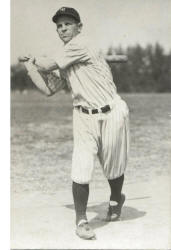 George Brace, was George Burke's
assistant, and took over the studio
after Burke's death in 1951. With
exclusive rights to the original
negatives, continued to distribute
Burke's photos & photographing players
into the early 1990's. Photographer Jim
Rowe who worked in the studio used the
negatives to produce real photo
postcards on Kodak Photograph paper.
George Brace, was George Burke's
assistant, and took over the studio
after Burke's death in 1951. With
exclusive rights to the original
negatives, continued to distribute
Burke's photos & photographing players
into the early 1990's. Photographer Jim
Rowe who worked in the studio used the
negatives to produce real photo
postcards on Kodak Photograph paper.
The postcard back with the heading "Photo Post Card" with the stamp box
wording "Kodak, Paper" dates to 1950
and later. The
Jim Rowe postcards
feature a Borderless black-&-white
photo on the front, and the back, a
standard Kodak postcard with no mention
of issuer. The players name was
typically penned in at the top. Rowe
also distributed Real Photo Post Cards
through James T. Elder, a sports card
dealer that ran a mail-order business
out of Odessa, Florida.
 The
James Elder postcards did generally
have a bordered black-&-white photo,
and at the bottom, a wider margin,
presumably allowing a for autographs.
The back had the standard Kodak RPPC
format but with a stamped catalog
number from 1 to 1400, which includes
75 Hall of Fame players.
The
James Elder postcards did generally
have a bordered black-&-white photo,
and at the bottom, a wider margin,
presumably allowing a for autographs.
The back had the standard Kodak RPPC
format but with a stamped catalog
number from 1 to 1400, which includes
75 Hall of Fame players.
The post cards were to be ordered by
the catalog number and players name.
The cards were .25¢ each and were
mailed out postage prepaid. Minimum
order of $1.00. A
complete set of 950 different postcard
photos cost $180.00, in 1966. The full
1,400 postcard set by 1968 cost
$280.00. Upon request Elder sent out a
20-page price list.
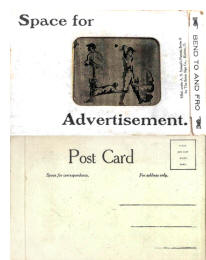 Patented in 1906 by Alexander S.
Spiegel, the
"Magic moving pictures," postcard
features a "display device" which
created an optical illusion of
movement.
Patented in 1906 by Alexander S.
Spiegel, the
"Magic moving pictures," postcard
features a "display device" which
created an optical illusion of
movement.
Manufactured under A. S. Spiegel's Patents, Series B, was used as a
salesman's sample to sell advertising
for the Sioto Sign Co., who produced
this Magic Motion postcard. Other
novelty companies were also granted
license to produce the cards.
Some postcards were produced by companies to be sold at travel
destinations, gift or souvenir shops.
 Circa 1925
postcard of the Stadium for
the House of David traveling baseball
team from Benton Harbor, Michigan.
People came for miles to see those
"Long Haired and Bearded" boys play in
the stadium which was built in 1911.
The House of David played against
Major, Minor, Independent and Negro
league teams.
Circa 1925
postcard of the Stadium for
the House of David traveling baseball
team from Benton Harbor, Michigan.
People came for miles to see those
"Long Haired and Bearded" boys play in
the stadium which was built in 1911.
The House of David played against
Major, Minor, Independent and Negro
league teams.
The community printed its own
postcards, with the sales of the
postcards helping to fund the
community. Real photo postcards Were
also used to produce House of David
postcards.
 The first world war brought paper
rationing in the United States and
across the world, causing cards of all
kinds to disappear for quite a while,
with the exception of a few regional
issues.
The first world war brought paper
rationing in the United States and
across the world, causing cards of all
kinds to disappear for quite a while,
with the exception of a few regional
issues.
In 1932 the Fendrich Cigar Co. issued a standard postcard featuring a
glossy black & white photo of a Chicago
Cubs player on the front, with a
typical postcard back.
The back also included an advertisement for Charles Denby 5¢ Cigars "Mild
- For Men Who Like To Inhale." This set
would be the last major tobacco card
issue produced before the second world
war.
See Checklist Here
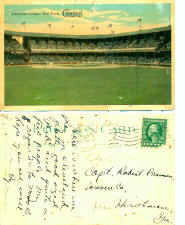 Postcards used by professional
ballplayers are highly sought after.
It's a personal look into the private
lives of the players we idolize. Ty
Cobb often corresponded with a close
friend named Capt. Robert Brannen.
There are many examples in the market.
Postcards used by professional
ballplayers are highly sought after.
It's a personal look into the private
lives of the players we idolize. Ty
Cobb often corresponded with a close
friend named Capt. Robert Brannen.
There are many examples in the market.
This
Ty Cobb personal postcard is dated by the
cancellation stamp to 1915, and reads:
Here is where we play in Cleveland,
pretty good sized park and quite a few
people. My regards to Mrs. B. Hope you
all well - Ty -"
If the cancelation stamp is illegible the postage can be used to
approximate the date the postcard,
using the chart in the left column.

Al Schacht was a Major League pitcher for the Washington Senators from
1919 to 1921. He later became a 3rd
base coach, and his comedic antics from
the coaching lines with fellow
Washington coach Nick Altrock, earned
him the nickname of "The Clown Prince
of Baseball." In 1942 Schacht
cited that tire and gas restrictions,
rationing for the war effort, forced
him to abandon his diamond antics and
he decided to open a cafe in New York. |
|
| |
 |
|
| |
Circa
1950, the front of the
Al Schacht's "Score Card" Restaurant
Bi-Fold Picture Postcards depict Al
Schacht in uniform, and tails with his
top hat raised in the air. The back of
the postcard: "History - The Story of
the $100. Bet" (click on image to read)
The Stamp Box reads; "You Address It,
We'll Mail It"
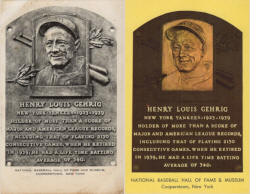 The first
Hall of Fame postcards were
issued in two types between 1939-1943.
One set issued prior to the Hall of
Fame's opening in June, 1939, and a
later version issued after that
opening, until 1943.
The first
Hall of Fame postcards were
issued in two types between 1939-1943.
One set issued prior to the Hall of
Fame's opening in June, 1939, and a
later version issued after that
opening, until 1943.
Albertype Black-and-White Postcards were published from 1944 to 1952 There
were two types. One, 1944-1945, reads
"Cooperstown, N.Y." (abbreviated)
below the plaque on the card front.
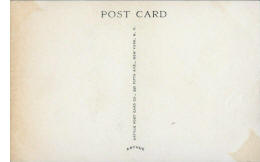 "New York" is not abbreviated on
the second type, produced from 1945 to
1952. From 1953 to 1963 Artvue began
producing the cards. These postcards
employed different fonts and different
backs than the Albertypes.
"New York" is not abbreviated on
the second type, produced from 1945 to
1952. From 1953 to 1963 Artvue began
producing the cards. These postcards
employed different fonts and different
backs than the Albertypes.
There are two types of Artvue postcards: type I, printed from 1953-55,
featured holes in the corners of the
plaques. Type II, produced from
1956-63, has bolts in the corner holes
of the plaque. The back feature a
simple postcard with no stamp box, and
the divider reads; "Artuve Post Card
Co., 225 Fifth Avenue., New York, N.Y."
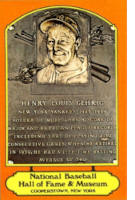 Yellow Plaque Postcards were published
from 1964 to 1978, then in 1980 to the
present. Curteichcolor produced the HOF
postcards from 1964 to 1980. In 1979,
Dexter Press published postcards in in
deferent colors; red, blue, green,
orange, etc... and in 1981 Mike Roberts
of Oakland California took over
production.
Yellow Plaque Postcards were published
from 1964 to 1978, then in 1980 to the
present. Curteichcolor produced the HOF
postcards from 1964 to 1980. In 1979,
Dexter Press published postcards in in
deferent colors; red, blue, green,
orange, etc... and in 1981 Mike Roberts
of Oakland California took over
production.
Senic Art began producing Hall Of Fame
postcards in 1997 and include; year elected to the
Baseball Hall Of Fame, and date of
printing.
|
|
| |
|
|
| |
KEYMAN COLLECTIBLES
RELATED RESOURCES |
|
| |
|
|
| |
|
|
| |
Half the fun of
collecting is showing off your collection to
others. Lets See your Room! |
|
| |
|
|
| |
Showcase
your collection on KeyMan Collectibles for Free!.
Just send pictures, and
Get Your Collectors Showcase Room Now! |
|
| |
|
|
| |
KeyMan
Collectibles Collectors Corner
- Keep up with the latest collecting news,
announcements, and articles of interest on the
webs best resource for baseball memorabilia. |
|
| |
KeyMan Collectibles Baseball
Memorabilia Facebook Group -
Post Questions and comments relating to
Baseball Collectibles and Memorabilia. Interact
with other collectors or show off your
collection. |
|
| |
KeyMan
Collectibles Forum
- A great option for those that "Don't do
facebook" Post Questions and
comments relating to Baseball Collectibles and
Memorabilia |
|
|
|
|
|
|
|

